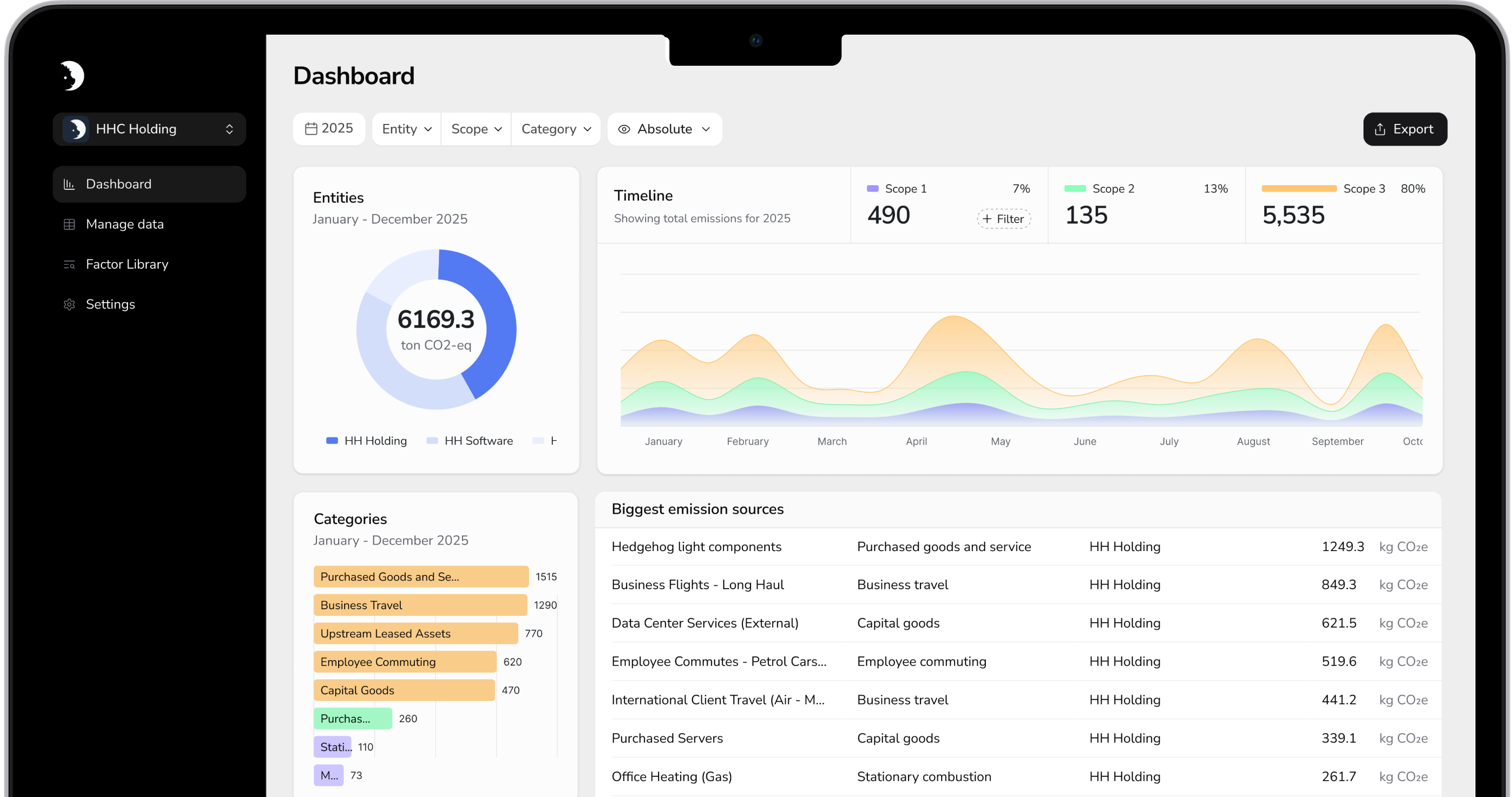Feeling the pressure to track your carbon footprint but unsure where to start with software? This guide helps busy SMEs compare options and choose the right tool for their needs.
The pressure on small and medium-sized enterprises (SMEs) to manage and report their carbon footprint is growing. Driven by new regulations like the Corporate Sustainability Reporting Directive (CSRD), demands from investors, and increasing customer awareness, understanding your company’s environmental impact is no longer optional. For SMEs ready to take meaningful climate action, the first step is accurate measurement.
Why spreadsheets aren't enough for carbon accounting
We see many businesses starting with spreadsheets when they begin with carbon accounting for the first time. While spreadheets seem like a simple, low-cost solution, they quickly become a significant bottleneck. Manual data entry is not only time-consuming but also highly susceptible to human error, which can undermine the credibility of your results.
We see that spreadsheets fall short specifically due to the following four reasons: They are...
- Time-consuming: manually collecting, inputting, and calculating emissions data is an inefficient use of valuable time that could be spent on, for example, carbon reduction strategies.
- Prone to errors: complex calculations and a lack of standardised methodologies increase the risk of inaccuracies, making it difficult to produce reliable sustainability reporting for SMEs.
- Not scalable: as your business grows and your operations become more complex, especially concerning scope 3 emissions, a spreadsheet-based system becomes unmanageable.
- Difficult to audit: spreadsheets lack the clear audit trail required for third-party verification, which is often necessary for compliance and building stakeholder trust.
Dedicated carbon footprint software automates these processes, ensuring accuracy, saving time, and providing a scalable, auditable platform for your journey towards net-zero. For more detail on different methodologies, our guide on choosing the right carbon accounting method can provide further clarity.
Key criteria for choosing carbon accounting software
Choosing the right tool requires a clear framework. When you compare carbon accounting software, focus on these essential criteria to find the best fit for your SME.
- Scope coverage and methodology: a robust platform must be able to calculate scope 1, 2, and 3 emissions according to established standards like the GHG Protocol. Scope 3 emissions, which cover your entire value chain, are often the largest and most complex portion of a company's footprint. Ensure the software has comprehensive capabilities to address all relevant categories, as this is crucial for a complete and accurate picture. Our article, "scope 1, 2 and 3 explained", offers a deeper dive into this topic.
- Ease of use and user interface: as an SME, you may not have a dedicated sustainability expert on your team. The best carbon accounting software for your needs will be intuitive and user-friendly. Look for a platform with a clear dashboard, guided workflows, and straightforward data input processes. This ensures that employees across different departments can contribute data without extensive training.
- Reporting and compliance features: your software should make reporting simple. Look for features that include pre-built templates for common frameworks like the CSRD, Science-Based Targets initiative (SBTi), and CDP. The ability to generate audit-ready reports is essential for meeting regulatory requirements and communicating your progress to stakeholders. Understanding the link between your measurements and regulatory demands is key, as explained in our article on carbon accounting and CSRD compliance.
- Data integration and automation: the most effective platforms can integrate with your existing business systems, such as accounting software, ERP systems, and utility providers. This automation streamlines data collection, reduces manual entry, and improves the accuracy and timeliness of your carbon footprint data.
- Cost and scalability: pricing models can vary significantly, from monthly subscriptions to usage-based fees. Consider the total cost of ownership, including any implementation or support fees. Choose a carbon accounting platform for your SME that not only fits your current budget but can also scale with your business as your reporting needs evolve.

Leading carbon accounting software for SMEs
The market for carbon accounting software is growing, with various platforms available. Some popular options include Normative, Greenly, and Plan A. These platforms offer a range of features suitable for different business needs.
At Hedgehog, we have developed our Carbon platform specifically with the challenges of SMEs in mind. It combines intuitive, easy-to-use software with access to our team of sustainability experts. This integrated approach ensures you not only get accurate data but also receive actionable guidance to develop effective reduction strategies. We even offer a free version to help you start your journey today, as detailed in our "free carbon footprint platform for business" article.
Making the right choice for your sustainability journey
Moving beyond spreadsheets to a dedicated carbon accounting platform is a critical step for any SME serious about its sustainability goals. By carefully evaluating software based on scope coverage, ease of use, reporting features, and cost, you can select a tool that simplifies compliance and turns data into meaningful action. An informed choice today will build a strong foundation for a credible and impactful net-zero strategy, helping you meet stakeholder expectations and contribute to a greener future.
Ready to simplify your carbon accounting? Explore the Hedgehog Carbon platform or contact one of our experts to learn how we can help you measure, analyse, and reduce your carbon footprint with confidence.






